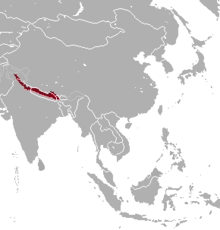Hemitragus jemlahicus
| Himalayan tahr | |
|---|---|
 |
|
| An adult male Himalayan tahr in Kedarnath Wildlife Sanctuary, Uttarakhand, India. | |
| Scientific classification | |
| Kingdom: | Animalia |
| Phylum: | Chordata |
| Class: | Mammalia |
| Order: | Artiodactyla |
| Family: | Bovidae |
| Subfamily: | Caprinae |
| Genus: |
Hemitragus Hodgson, 1841 |
| Species: | H. jemlahicus |
| Binomial name | |
|
Hemitragus jemlahicus (Smith, 1826) |
|
 |
|
| Range map | |
The Himalayan tahr (Hemitragus jemlahicus) is a large ungulate native to the Himalayas in southern Tibet, northern India and Nepal. It is listed as Near Threatened on the IUCN Red List, as the population is declining due to hunting and habitat loss.
Results of a phylogenetic analysis indicate that the genus Hemitragus is monospecific, and that the Himalayan tahr is a wild goat.
The Himalayan tahr has been introduced to New Zealand and South Africa.
The word "tahr" comes from the Nepali language and was first used in English writing in 1835. Tahrs belong to the order Artiodactyla, which denotes an even-toed ungulate mammal. Close relatives to the Himalayan tahr also associated to the Caprinae subfamily include sheep and goats.
A subspecies, the Eastern Himalayan tahr or shapi, was described in 1944. However, this classification is no longer regarded as valid and no subspecies are currently recognized.
The Himalayan tahr has a small head, small pointed ears, large eyes, and horns that vary between males and females. Their horns reach a maximum length of 46 centimetres (18 in). Himalayan tahrs are sexually dimorphic, with females being smaller in weight and in size and having smaller horns. The horn is curved backwards, preventing injury during mating season when headbutting is a common mating ritual among males. The average male tahr usually weighs around 73 kg with females averaging 36 kg and is shorter in height than in length The exterior of a tahr is well adapted to the harsh climate of the Himalayans. They sport thick, reddish wool coats and thick undercoats, indicative of the conditions of their habitat. Their coats thin with the end of winter and becomes lighter in color. This shedding is presumably an adaptation that allows their internal body temperatures to adjust to the harsh temperatures of the Himalayan Mountains.
...
Wikipedia

